Eric
Vandenbroeck 17 June 2018:
While South Korea and
the United States are expected to announce the
suspension of "large-scale" military drills this week, with the
provision that they would restart if North Korea failed to keep its promise to
denuclearize, news agency Yonhap said on Sunday. The world is muddling through a blurry
transition from the post-Cold War world to an emerging era of great power
competition.
Moscow Tries to Break
a Stalemate with Washington. Poland and other borderland states will make
appeals for stronger security guarantees from Washington while they still have
the United States' attention. Russia will try to break a negotiating stalemate with
the United States to talk sanctions, military build-ups and arms control by
promoting its mediation in the Syrian conflict and its potential utility in
North Korean denuclearization. Don't hold your breath for a breakthrough,
though.
In harnessing the
power of tariffs and extraterritoriality in sanctions, the United States will
polarize many of its security allies in Europe and Asia - strategic partners
that Washington needs to counterbalance the emerging threat from China and
Russia. Attempts to target Russia's strategic relationships will call into
question the long-term reliability of the United States as a defense partner
and invite heavy pushback from Turkey, Vietnam, Germany and India, in
particular.
As the limits of EU
economic safeguards are exposed, Tehran will cautiously walk back its
commitments to the nuclear deal while seeking out willing partners to
circumvent sanctions. Russia will take advantage of Iran's rising vulnerability
to deepen its military ties with Tehran while mediating between Iran and Israel
in Syria. Turkey will be a big feature of the third quarter following a
precarious electoral gamble by Turkish President Recep Tayyip Erdogan. Erdogan
has the tools to eke out a win and whip up a nationalist reaction to any
outside questioning of the vote, but the highly polarized country will remain
on shaky economic ground amid worsening relations with the West.
Mexico's populist
candidate stands a chance of winning big in July elections, which could pose a
threat to energy and education reforms while further complicating NAFTA talks.
A strong anti-establishment current will also be on display in Colombia, where
the FARC peace deal is under threat, and in Brazil and Argentina, where the
appetite for economic reform will plummet.
With several
negotiations still pending - including discussions over the fate of the Korean
Peninsula and high-stakes trade talks - a world weary from grappling with the
fitful superpower is bracing itself for another quarter of whiplash from White
House maneuvers.
But while Trump
thrives on unpredictability as his chief negotiating tactic, many of his moves
fit quite neatly - even predictably - in the context of the United States'
great power rivalry with China and Russia. The United States' intensifying
economic pressure on China, its harder-hitting
sanctions on Russia and its growing support for critical borderland states,
such as Taiwan, Ukraine and Poland, are all a part of this budding competition.
Even the U.S. search for a way to reunify and denuclearize the Korean Peninsula
is a piece of a broader long-term strategy to balance against China.
Yet the United States
is creating bigger distractions for itself in the Middle East with Iran while
putting stress on the very alliances it needs in its global competition with
China and Russia. Although the contradictions in U.S. policy are taxing much of
the world, this prolonged state of confusion is par for the course as the world
muddles through a blurry transition from the post-Cold War world to an emerging
era of great power competition.
For example U.S.-China Competition
Builds
Narratives casting
China as an economic imitator, as opposed to an innovator, are out of date. As
the country grows more economically advanced, focusing its attention on
game-changing technologies, the United States will heighten its economic
scrutiny on China - and squeeze numerous companies along U.S.-Asian supply
chains in the process. This dynamic will endure well beyond the quarter and the
Trump presidency. In the name of national security, the executive and
legislative branches of the U.S. government will continue to target the Made in
China 2025 strategic development program through various means, including
tariffs, sanctions and restrictions on investment and research. U.S. companies,
particularly those involved in sensitive technology sectors, will face growing
risk and uncertainty over the potential for export controls and for closer
monitoring of foreign investments.
Specific measures to
watch for in the third quarter include a special investment regime for Chinese
companies designed to block investment into sensitive areas like robotics,
telecommunications, semiconductors, artificial intelligence (AI), virtual and augmented
reality, and new energy. The White House already has announced its intention to
impose tariffs on up to $50 billion worth of Chinese industrial technology
goods under a Section 301 investigation into Chinese intellectual property and
technology theft. (More details are expected June 15.) The United States will
apply tight scrutiny to outbound investment to or informal collaboration with
Chinese companies, especially in high-tech sectors. Telecommunications firms
Huawei and ZTE are already feeling the pressure; the U.S. Commerce Department
has slapped hefty penalties on ZTE, while Huawei is under investigation by the
Justice Department. In addition to those companies, the United States could
expand its net to ensnare tech giants like Baidu, Alibaba and Tencent,
launching investigations into web services they provide. Washington is also
likely to impose visa restrictions on Chinese researchers and students in the
United States.
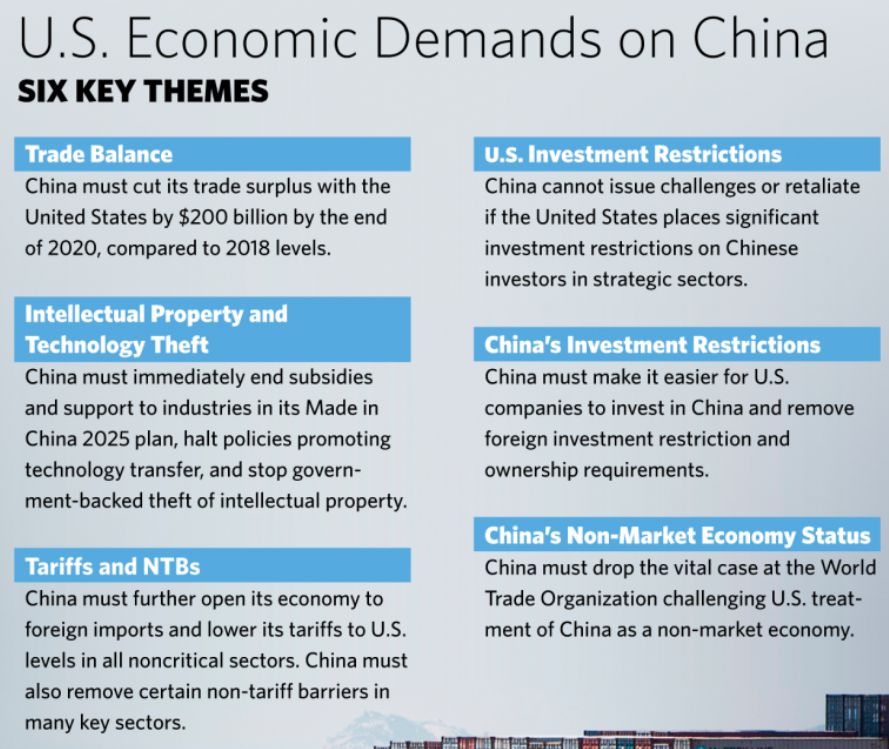
And while there
currently is a
lot of talk about a major trade war, Washington and Beijing alike will eventually
make concessions to justify dialing back their more extreme tariff threats.
Still, the negotiations will be bumpy. There are hard limits to what each side
can concede, and Chinese compliance is not assured, leaving the door open for
some tariffs, and retaliatory measures, to shake out this quarter.
Internal White House
dynamics will also be key to watch in tracking the progress (or lack thereof)
in trade negotiations. Treasury Secretary Steven Mnuchin and White House
economic adviser Larry Kudlow will push for a compromise that minimizes
collateral damage, while economic adviser Peter Navarro and U.S. Trade
Representative Robert Lighthizer drive a much harder, and perhaps impossible,
bargain with China. In the lead-up to U.S. midterm elections, the White House
will probably be more sensitive to retaliatory tariffs targeting the U.S. farm
belt, where support for Trump was strong during the 2016 presidential race.
Tariffs on smaller crops such as cranberries and ginseng, for example, could
hit a political nerve in Wisconsin, a state in which the farming vote could
make a big difference.
Even as the
negotiation inches ahead, the United States won't prevent China from providing
heavy, focused support to Made in China 2025 sectors. The U.S. pressure will
only make China more determined to accelerate its drive to forge its own supply
chains for sensitive technologies. China will, however, be willing to negotiate
ways to increase U.S. imports, including of energy, semiconductors, vehicles
and agricultural products; to partially liberalize certain sectors, such as the
financial sector; to reduce some trade barriers for imported vehicles; to
enhance intellectual property protection rights; and to restructure state-owned
enterprises as part of its reform drive. Even if the United States hits it with
tariffs this quarter, China has the political and economic means to withstand
the blow at home. A growing number of maturing corporate bonds will add to the
financial strain on local state-owned and private enterprises, but Beijing will
inject liquidity selectively to ease the pain, particularly in central and
northeastern China, and to manage any fallout.
A Framework for North Korean Denuclearization
Trump and North
Korean leader Kim Jong Un will meet face-to-face June 12 for a much-anticipated
summit in Singapore. While there will be moments throughout the process where
it appears as if the whole dialogue is collapsing, there is reason to believe
that the negotiation will still have legs by the end of the quarter. Our focus
will not be so much on the drama to come, the typical walk-outs, name-calling
and muscle-flexing - as Trump and Kim battle to prove who can play the
unpredictability card most effectively in the talks. Setting aside the theater
of the negotiation, the fundamental question for the quarter is whether both
sides will muster enough political will to develop a framework for
denuclearization. If a dialogue advances, it will likely start with freezing
nuclear development, leaving room to tighten the screws on denuclearization
over time. Just as the United States is unwilling to offer North Korea instant
regime security, North Korea will negotiate denuclearization only over a long
period of time.
Compared with
previous efforts at negotiation, the stakes are much higher this time around.
North Korea is closer than ever to its nuclear deterrent, and if the talks
fail, the United States will have invalidated the diplomatic route. The United
States would find it difficult to build international consensus to reinstate
crippling sanctions on North Korea, much less a consensus to pursue a military
option.
But a breakdown in
talks with the United States would not necessarily lead North Korea to resume
its nuclear testing immediately. Even if the United States walks away, China
and South Korea would keep up the diplomatic momentum with North Korea, giving
Pyongyang an opportunity to press its neighbors to ease up on their own
economic sanctions.
Japan will remain
largely on the sidelines of the negotiation, given its frosty ties with South
Korea and even frostier ties with North Korea. As trade tensions mount between
the United States and Japan over the threat of auto tariffs, Tokyo will do its best
to keep them separate from its security partnership with the United States.
Japan's biggest concerns lie in North Korea's short- and medium-range ballistic
missile threats and any short-term shifts to the U.S. force presence on the
Korean Peninsula that could also lead to a drawdown in Okinawa before it is
politically and militarily ready to compete with China. Japanese Prime Minister
Shinzo Abe will try to keep a high diplomatic profile this quarter both to try
to insert Japan's security interests into the U.S.-North Korea dialogue and to
distract his own constituency from a scandal that threatens his six-year
tenure. Should Abe lose the critical contest for the ruling party's leadership
in September, Japan could enter another period in which prime ministers come
and go more frequently, creating more uncertainty as the great power
competition in the Pacific heats up.
If the United States
can manage to avoid a military conflict with North Korea, it will be able to
apply more resources and attention to reinforcing countries in China's
borderlands. Though China has managed to ease tensions with the states in its
periphery, its continued militarization in the South China Sea will draw the
United States into a more active military role in the region to balance it. The
United States will increase naval deployments and patrols in the South and East
China seas this quarter while working to expand military exercises with members
of the Association of Southeast Asian Nations (ASEAN). An increase in U.S.
deployments will lead to a period of heightened tension between Chinese and
U.S. forces in these waters, and instances of harassment could become more
frequent as the rate of close encounters and interceptions increases.
Friction Points in the U.S.-Russia Relationship
Russia's influence over
North Korea will remain limited so long as Washington sustains its diplomatic
engagement with Pyongyang through the quarter. If the talks make progress,
Russia will try to secure a role in the denuclearization process to make sure
it has a seat at the table. And should the talks collapse, Russia will align
itself closely with China to resist the United States in the U.N. Security
Council on sanctions and military action.
The push and pull
between the U.S. Congress and the president on Russia policy can be messy and
contradictory at times, but the result tends to be a harder U.S. line on the
country. Congress will lean on the Treasury Department to sharpen its aim in
targeting Russian elites with an eye toward sowing divisions in the Kremlin
without creating the kind of significant global economic blowback that
sanctions against Russian aluminum producer Rusal caused in the second quarter.
At the same time, U.S. lawmakers will be working to implement the
Russia-related provisions of the Countering America's Adversaries Through
Sanctions Act (CAATSA) to coerce other countries to reduce their defense,
intelligence and energy ties with Russia.
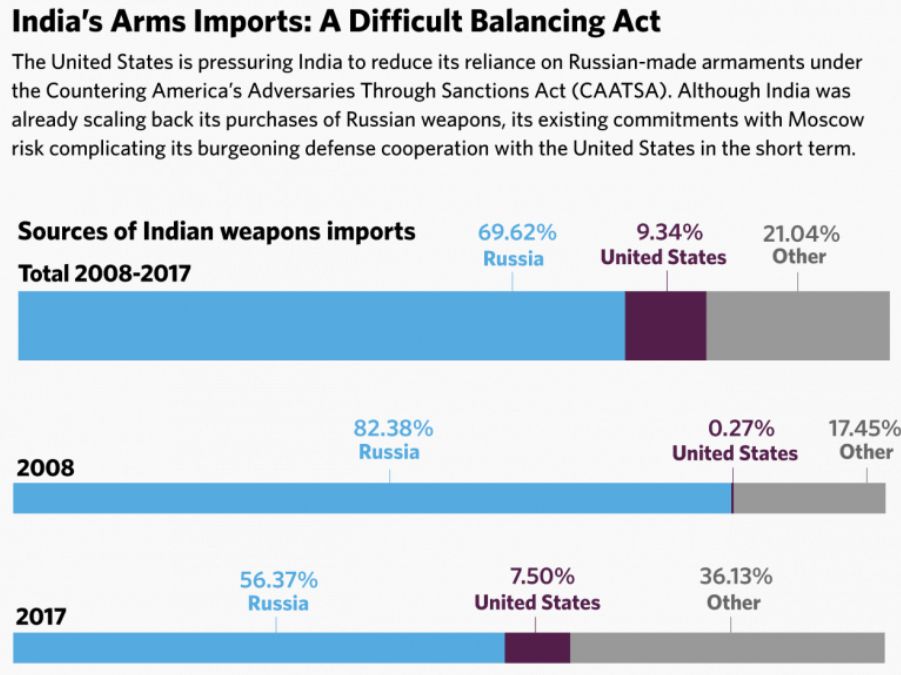
Though the White
House has been more reluctant in the past to confront Moscow, secondary
sanctions targeting Russia's defense and energy sales appeal to its business
sense by creating more export opportunities for U.S. liquefied natural gas
producers. They will also appeal to the United States' business sense by
potentially creating more export opportunities for U.S. defense firms and for
U.S. liquefied natural gas producers. Commercial interests, along with a
growing U.S. strategic focus on Central and Eastern Europe in its competition
with Russia and China, will give Poland, Ukraine and the Baltic states an
opportunity to appeal to the White House for stronger security commitments.
Warsaw, in particular, will try to advance talks with Washington over a permanent
U.S. military presence in Poland, which will in turn cause Russia to up the
pressure on Belarus to host a Russian airbase in its borders.
A potential military
buildup in Russia's periphery is one of several factors that could prompt a
high-level dialogue, or at least preparations for one, between Washington and
Moscow this quarter. Russian President Vladimir Putin has a long list of items ready
for when he sits down with Trump, including sanctions, military buildups and
stymied arms control talks. Russia will try to use its mediation in the Syrian
conflict and offers to help with North Korea's prospective denuclearization to
present itself as a more constructive force. But the White House will engage
with Moscow at a high level only if it feels that it has made enough progress
on North Korea that it can deflect negative attention from the Russia-related
investigations underway. Even if Trump and Putin manage to set up a meeting,
the geopolitical environment will not be conducive to a grand bargain.
Having made it to a
fourth term in office in elections in March, Putin will have to maneuver
carefully among the government, his inner circle and Russia's powerful
oligarchs as the United States dangles the threat of heavy sanctions over them.
Efforts to consolidate the assets of Russia's elite will continue in the third
quarter, as the Kremlin works to maintain economic stability and political
loyalty. Higher oil prices will help ease some of the strain that honoring
social pledges made during the campaign season, increasing security spending
and hosting the World Cup have put on the Kremlin's finances. Competition among
the security services remains a key area to watch as Putin balances among rival
factions. We'll also be watching carefully for further signs that the longtime
president is elevating younger members of the elite in search of a successor.
The more immediate
priority in the quarter will be for Putin to try to take more steam out of
opposition protests. In the second quarter, a wave of opposition protests in
Armenia that swept longtime leader Serzh Sargsyan from power was another
wake-up call for the Russian government and the heads of other former Soviet
states: Once a protest movement has gathered enough momentum, not even brute
force tactics can quell it. Determined to avoid a similar fate, the Kremlin
will work on co-opting opposition leaders into government positions. Opposition
leaders like Alexei Navalny are unlikely to fall for this strategy. But figures
from other prominent dissident parties - especially those that stand to do well
in September's regional elections, including Yabloko and the Communist Party -
may yield to the Kremlin.
Doubling Down on Iran
A big element of the
U.S.-Russia competition will also play out in the Middle East. In walking away
from the Iran nuclear deal and reinstating hard-hitting sanctions, the White
House is hoping against all odds to foment enough economic frustration in Iran
to set regime change in motion. Israel, meanwhile, is seizing a rare
opportunity to escalate its military campaign against Iranian and Hezbollah
assets in Syria, knowing that it has firmer security guarantees from the United
States to manage the fallout of a cycle of attacks and retaliatory attacks that
risks drawing in Russia. Moscow will plan its next steps carefully with the aim
of avoiding a direct collision with the United States while exploiting U.S. and
Israeli needs to deconflict on the Syrian battlefield. Despite its attempts to
mediate between Israel and Iran - in hopes of bargaining on a more strategic
level with the United States - Russia's limited influence on the Syrian
battlefield will prevent a lasting truce. Russia also will try to take advantage
of Iran's vulnerability with the United States to deepen its own military
footprint in the region. Watch for discussions between Iran and Russia over
boosting Iranian air defenses and appeals from Moscow for access to Iranian
bases.
Tehran's focus for
the third quarter will be to buy itself as much room to maneuver as possible
with those trading partners willing to risk U.S. secondary sanctions. In the
immediate term, Iran will take care to avoid aggressive actions that could push
the European position closer to that of the United States. But as the limits of
the European Union's economic guarantees become more evident in the coming
months, Iran's internal debate over how to proceed will intensify. Iran will
probably still confine retaliatory attacks against Israeli strikes in Syria to
the Golan and potentially the Palestinian territories as it tries to avoid a
bigger conflagration. It will also test the limits of the nuclear deal and its
cooperation with Europe, for instance by threatening to increase enrichment, to
limit access to International Atomic Energy Agency inspectors or to withdraw
from the Nuclear Non-Proliferation Treaty.
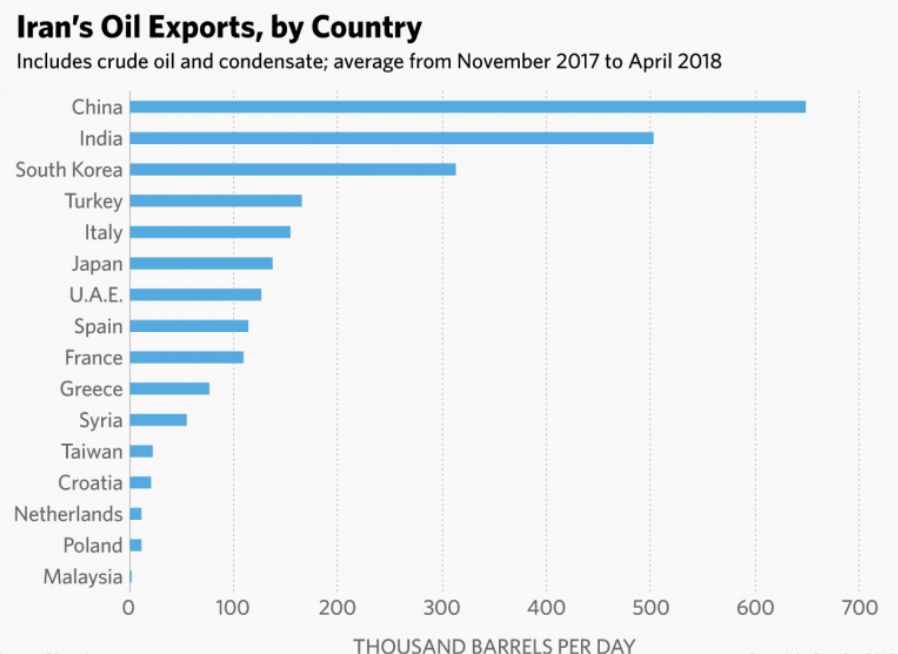
The European Union,
for its part, has imposed regulations to block the application of U.S.
secondary sanctions to European companies. In addition, it will consider such
measures as compensating EU firms for their losses in Iran, increasing
euro-denominated trade with Iran, offering new credit lines for companies doing
business in the country and arranging currency swaps to bypass the U.S.
financial system. Italy, France and Germany will be the most motivated to set
up financial mechanisms to continue trade with Iran. Likewise, smaller Chinese
and Russian firms with fewer connections to the U.S. financial system will be
willing to maintain or even expand their economic ties with Iran. But most
corporations with financial exposure to the United States will make the
pragmatic choice to reduce or eliminate their ties to Iran to maintain access
to the U.S. market. And even China will be wary of defying the United States
because of the case involving ZTE, which Washington hit with a crippling
punishment for flouting sanctions.
Growing economic
strain will continue to depress the value of the Iranian rial and spur
inflation, creating a groundswell of domestic discontent that could drive
sporadic demonstrations. But Iran has already been preparing its economic
insulation strategy. To muddle through, the Iranian government will emphasize
domestic production and negotiate agreements and barter arrangements in
nondollar trade. Tehran will also work on financial reform to comply with
international banking regulations as part of a broader effort to cushion the
blow of U.S. sanctions. Since the United Arab Emirates is on more hostile terms
with Iran today than it was when the Islamic republic was last under crippling
sanctions in 2012, Tehran will depend more this time on Qatar and Oman to
re-create a web of financial and shipping methods to skirt the measures.
Similarly, Turkish banks - now under much tighter U.S. scrutiny - probably
won't be as reliable an option for circumventing sanctions this time around,
though Turkey will maintain significant economic ties with Iran.
The Cost of Alienating Allies
The White House is
stretching the limits of executive action in fighting multiple battles on the
economic and foreign policy fronts. By harnessing the power of tariffs and
extraterritoriality in sanctions, the White House will polarize many of the
security allies it needs to counter an emerging threat from China and Russia.
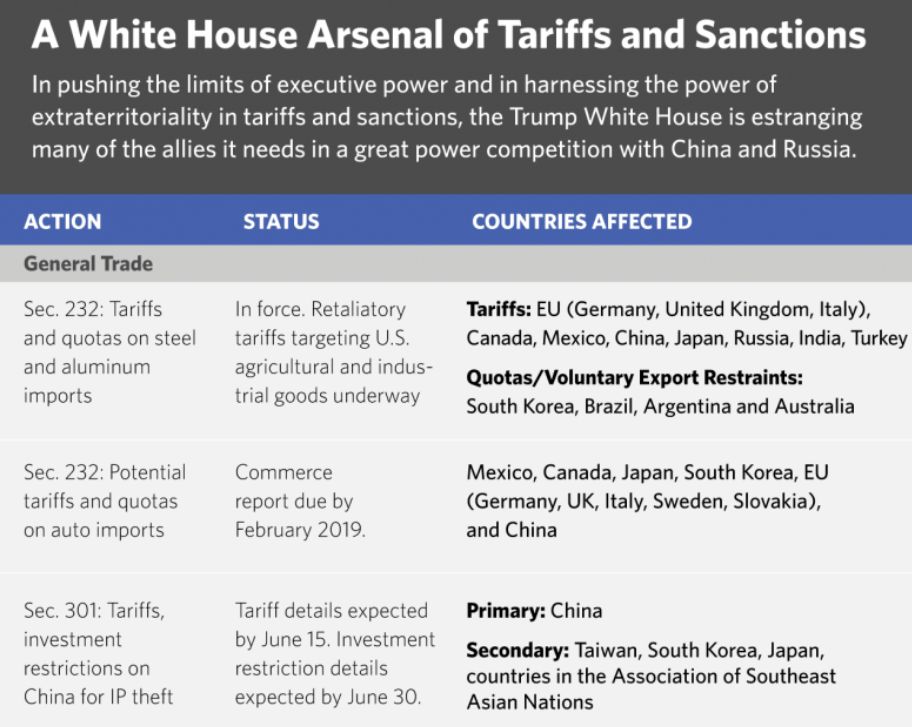
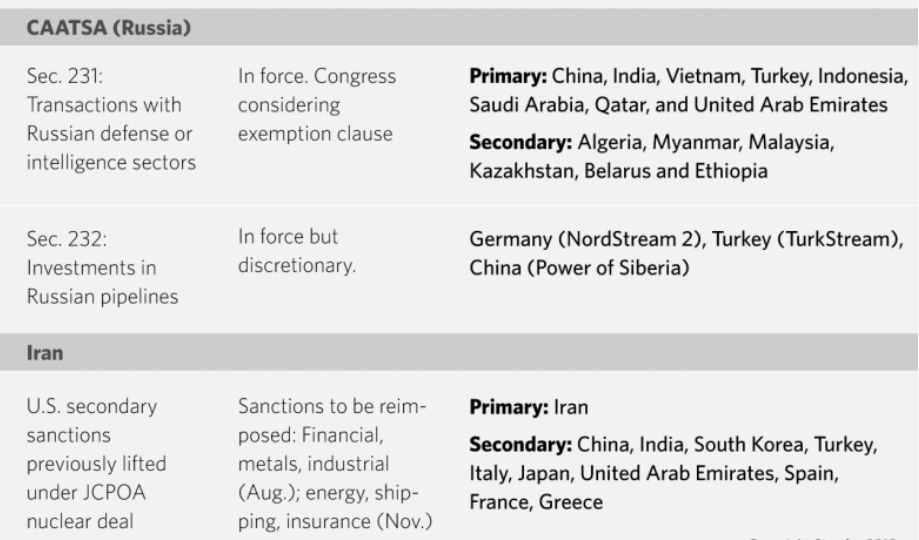
Taiwan and South
Korea, and to a lesser extent Japan and ASEAN, are the most exposed to major
disruptions in the U.S.-China supply chain and are bracing themselves for
blowback from the tariffs that may emerge from the U.S.-China economic
standoff. The threat of auto tariffs this quarter will add strain to the United
States' relationships with South Korea and Japan, though Seoul may have a
better shot at negotiating exemptions as part of its talks to revise the United
States-Korea Free Trade Agreement.
Europe, too, is
caught in the middle of this broader competition. Costly tariffs and unilateral
sanctions are stirring the Continent to reclaim its economic sovereignty from
its long-standing Western partner across the Atlantic. The problem is that
Europe is not a single nation with a unified voice. Germany, whose heavy
dependence on exports gives it incentive to a find compromise with the United
States, particularly as the threat of auto tariffs looms, will not be able to
negotiate a comprehensive trade agreement among more skeptical EU member states
to try to defuse trade tensions with Washington. Nevertheless, the European
Union will consider more modest measures to appease the United States, such as
eliminating reciprocal tariffs on industrial products (and lowering the EU
tariff on cars), reducing regulatory barriers to trade and restricting exports
or introducing import quotas.
France will lead the
battle to maintain the European Union's relevance in the face of great power
competition and growing U.S. unilateralism. Paris will work this quarter to
strengthen Europe's strategic autonomy through defense cooperation pacts,
including the Permanent Structured Cooperation (PESCO) and the European
Intervention Initiative. In trying to ensure Europe is still in the global race
to develop AI alongside the United States and China, France will try to
spearhead a European strategy for the technology. Connected to this goal, the
European Commission will work to deepen the digital single market by
eliminating barriers to international e-commerce while protecting consumers.
But fragmented markets and differing regulations among member states will slow
progress to that end. The complications from EU fragmentation will be on
display this quarter when the bloc starts implementing the General Data Privacy
Regulation and could undermine AI development on the Continent in the long
term.
France will also try
to drive a discussion around reforming the World Trade Organization (WTO),
another casualty of U.S. unilateralism. The United States has made a legally
explosive national security argument under Section 232 of the Trade Expansion
Act of 1962 to justify protectionist measures on imports of steel, aluminum and
now automobiles and auto parts. While polarizing key allies in Europe and Asia,
the Section 232 cases also put U.S. Gulf partner Qatar in the uncomfortable
position of battling the United States in the WTO. Doha has cases against Saudi
Arabia, the United Arab Emirates and Bahrain for waging an economic attack on
it in the name of national security. Either way the case goes, the risks are
high: If the WTO upholds the national security argument for trade
protectionism, it will set a dangerous precedent, and if it shoots down the
U.S. case, it will risk exacerbating its credibility crisis should the United
States ignore the ruling altogether.
Managing Difficult Relationships
Europe, in turn, is
trying to demonstrate its support for the United States in countering China's
trade abuses, but not at the cost of wrecking the WTO's credibility. The
approach of an EU-China non-Market Economy case and the precarious position of
the WTO Appellate Body will prompt the European Union to push for a reform
dialogue and mediate between the United States and China. But the United States
won't be receptive to Europe's appeals this quarter while it's still on the
economic warpath. Despite calls from Macron, a serious discussion on reforming
the WTO that has any chance of keeping the United States engaged will have to
come later.
A concerted push by
the U.S. Congress to get CAATSA up and running will further complicate U.S. security
relationships abroad. The legislation contains a secondary sanctions provision
for states engaged in significant defense, intelligence and energy transactions
with Russia. The U.S. executive branch will still be able to rely on a national
security waiver to exempt more sensitive allies from punitive measures, but the
legislation is designed to hold the White House accountable for other
countries' efforts to steadily reduce their strategic ties with Russia in
exchange for the waivers. Germany, Vietnam and Turkey are the states most
likely to defy U.S. pressure on their Russia relations, while India is the most
vulnerable and will struggle to find a balance between Moscow and Washington.
The CAATSA drive could in some cases generate defense sales opportunities for
foreign competitors if countries think the United States is too unreliable a
defense partner.
A Turbulent few months for Europe
A Euroskeptic
government has taken hold in the European Union's core: The new Italian
government, led by Euroskeptic and nationalist parties the Five Star Movement
and the League, will try to reverse austerity policies instituted by prior
governments and increase spending. Specific measures include abolishing a
controversial pension reform, lowering household taxes and increasing
assistance for low-income families. Moving the proposals forward will be no
small feat and will require the government to overcome internal divisions and
institutional constraints. Even so, because of the expense - and the challenge
to EU fiscal deficit rules — that the measures entail, EU institutions and the
German government will be on guard. Italy will be ready to ignore EU deficit
and debt rules in bargaining with Brussels, but it won't go so far as to make a
unilateral move to pull out of the eurozone this quarter. And even though Italy
isn't facing an imminent financial crisis, the country's defiance toward EU
fiscal rules is still a threat to the currency area. After all, Italy will be
looking for allies in Southern Europe, including France, Spain and Greece, to
join its calls for increased spending at the continental level and more
flexible EU fiscal rules.
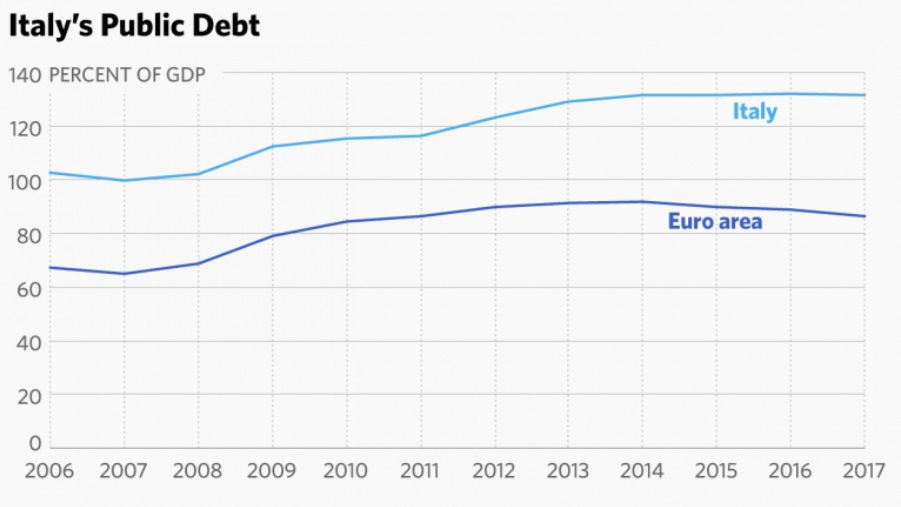
Italy's closer ties
with Russia will raise concerns in the European Union - and hope in Moscow -
that Rome could keep the bloc from reaching the unanimous vote required to
uphold EU sanctions on Russia. Italy could demand a review of the measures and
greater justification for continuing them during the EU debate, but Rome is
unlikely to take too strong a stand on Russian sanctions when it has a much
bigger battle with Brussels looming over its economic agenda. A potential
Italian rebellion is one of several factors driving an EU debate over how to
escape the "unanimity trap." Watch for an important proposal from the
European Commission this quarter that would streamline decision-making by
allowing the bloc to make decisions on foreign policy issues by a majority
vote. The change, if eventually adopted, could threaten states' national
sovereignty on critical foreign policy matters.
While Italy spooks
the eurozone, the German government, under pressure from both conservative
lawmakers at home and from its allies in Northern Europe, such as the
Netherlands, will try to shelve, postpone or water down reform proposals from
France. We expect the two to reach agreement on issues such as the introduction
of mechanisms to increase investment across the European Union, the
introduction of a common backstop for eurozone banks or the creation of a
European monetary fund. But they will probably postpone more controversial
plans, such as the introduction of a common guarantee for deposits in eurozone
banks, or at least link the proposals to measures to reduce financial risk in
the region's banks.
France and Germany
likely will abandon other suggestions, including the creation of a finance
minister for the eurozone. The continued debate over the EU budget will add to
the friction. Net contributors - most of which are in Northern Europe - will
resist enlarging their national contributions to the budget, while net
receivers of structural funds (mainly in Eastern Europe and, to a lesser
extent, Southern Europe) will fight to keep their share. Proposed cuts to
agricultural subsidies will rile up farm lobbies in France, Spain, Ireland and
elsewhere. And states in Central and Eastern Europe will form a united front
against Brussels' attempts to make the disbursement of EU funds contingent on
respecting the rule of law.
Adding to the
political risk in the eurozone, the Brexit process will become increasingly
toxic this quarter. The British government will have to deal with an
increasingly rebellious Parliament, where the idea of remaining in the customs
union is gaining traction. The British government has until the EU summit in
late October to try to patch up this divide while bargaining with Brussels over
its two seemingly incompatible goals of leaving the customs union while
maintaining an open border between Ireland and Northern Ireland. The longer
London plays for time, though, the weaker and more divided the government will
become - increasing the chances of Parliament taking control of the Brexit
process and keeping the United Kingdom in the customs union.
Market Volatility in the Energy Sector
In anticipation of
the return of U.S. sanctions on Iran's oil exports Nov. 4, many countries will
work to reduce their oil imports from the country throughout the quarter. Along
the way, they could create a gap in supply in global oil markets that threatens
to drive up prices. The size of the gap will depend on how stringent the United
States will be in granting sanctions waivers to countries that reduce their oil
imports from Iran. Under former President Barack Obama's administration,
countries could qualify for waivers after cutting their imports of Iranian oil
by around 20 percent, but the Trump White House could raise the requirement.
(Either way, the U.S. sanctions will gradually reduce Tehran's incentive to
stay in the Iran nuclear deal since countries must keep lowering their imports
to continue qualifying for the waivers.) The key White House negotiations to
watch in the quarter will be with EU members - especially ltaly,
Germany and France - China, South Korea and India. We can expect at least
400,000 barrels per day of Iranian oil to go offline by the end of the year.
Saudi Arabia and its
Gulf Cooperation Council (GCC) allies Kuwait and the United Arab Emirates, as
well as Russia, will keep an eye on the oil market this quarter in case they
need to intervene. Along with the drop in Iranian oil exports, big production declines
in Venezuela and Mexico will require Russia and the GCC states to work together
to make up the shortfall. When the world's major oil producers meet in Vienna
on June 22, they could agree to loosen oil production quotas while watching and
waiting for the Iran developments to take their toll on the markets. The group
of oil producers participating in the production cap has already met its goal
of returning global oil inventories to five-year averages to restabilize the
market. As a result, its members have more room to increase production as
needed.
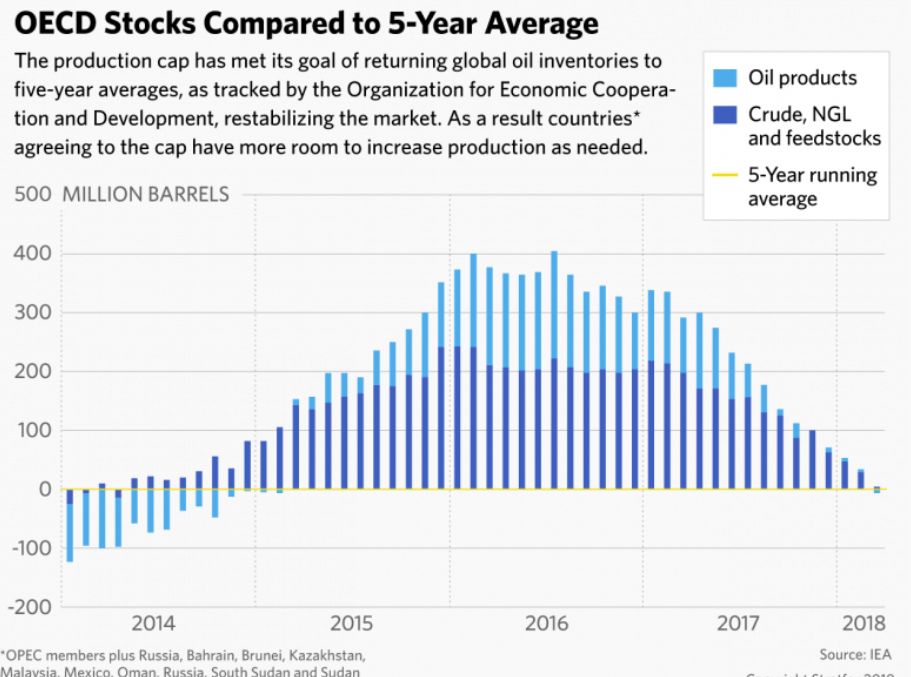
Saudi Arabia,
however, will be cautious in planning a market intervention. Riyadh is aiming
for a higher price band (possibly around $100 per barrel) in preparation for
the initial public offering of its state-owned oil company, the Saudi Arabian
Oil Co., and in a bid to reduce its budget deficit. But Saudi Arabia will have
to weigh those economic considerations against its strategic partnership with
the United States. The White House will be leaning on Riyadh to intervene in
the oil market and prevent a big hike in gasoline prices ahead of U.S. midterm
elections. The Saudi government may well acquiesce.
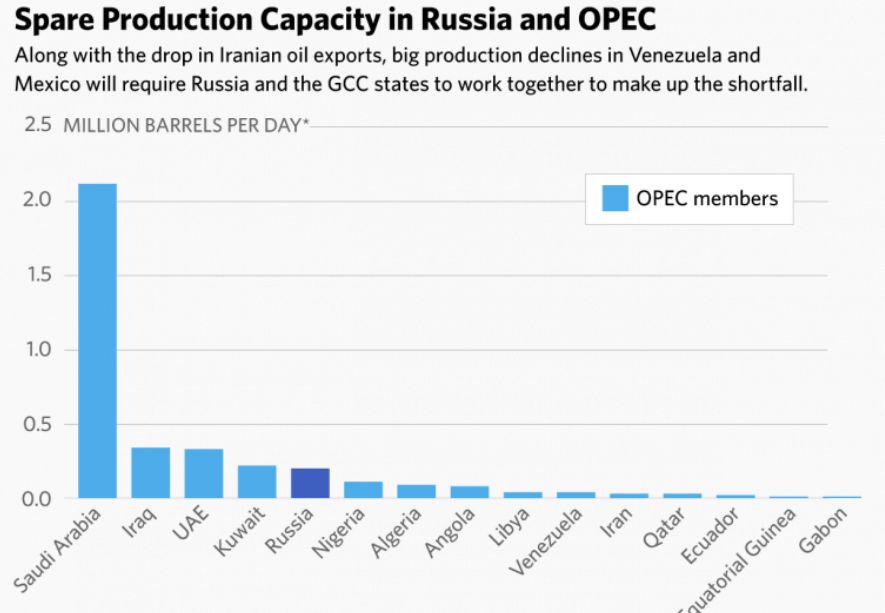
When we step back and
assess the main sources of geopolitical risk to the global economy the next few
months, it's a mixed bag. Trade frictions will be high on multiple fronts, but
they are unlikely to spiral into a trade war. There will be dramatic episodes
in the U.S.-North Korea negotiation, but the risk of a military scenario will
be low. Iran's risk to oil markets is largely known and underway. The election
of a Euroskeptic government in Italy is driving up financial risk in Southern
Europe. A confluence of macroeconomic factors is at the same time creating a
perfect economic storm over several spots on the map.
The U.S. Federal
Reserve appears to be on course for further monetary tightening this year,
while other major central banks are proceeding with caution, creating upward
pressure on the dollar. Combined with higher oil prices, the dollar's rise will
compound pressure on countries that have large energy needs. The pain will be
more acute for those countries with high amounts of dollar-denominated debt
that are more vulnerable to swift capital outflows when spooked investors take
cover under safer assets. The resulting currency pressures will stoke inflation
and aggravate political problems in many countries, including Turkey,
Argentina, Brazil, Colombia, Mexico, South Africa, India and Venezuela.
Turkey
Turkey will hold
presidential and parliamentary elections June 24, a year and a half ahead of
schedule. Turkish President Recep Tayyip Erdogan has a lot riding on the vote
after narrowly winning a referendum to enhance the powers of the presidency; if
he wins, he could remain in the presidency until 2029. By holding the election
so early, Erdogan is trying to head off both a nascent opposition coalition and
an economic hailstorm pelting his voter base. Turkey's electorate is
essentially split down the middle, and a diverse set of opposition parties are
forming a coherent argument against Erdogan and his handling of the economy. An
election that could yield narrow margins and end in a runoff raises the
potential for vote rigging and public outcry, but Erdogan will have the benefit
of power working in his favor.
The incumbent
president can rely on the country's state of emergency to manage any fallout,
all the while spinning any criticisms from Europe into nationalist propaganda.
Turkey's hefty dollar-denominated debt, together with Erdogan's attempts to
strong-arm the central bank to defy market pressure, will make this a
particularly stressful quarter for the Turkish economy. On top of the country's
political and economic woes, Turkey is facing stiff headwinds in its strained
relationship with the United States as Washington tries to leverage secondary
sanctions against Russia and Iran to constrain Ankara's relations with them.
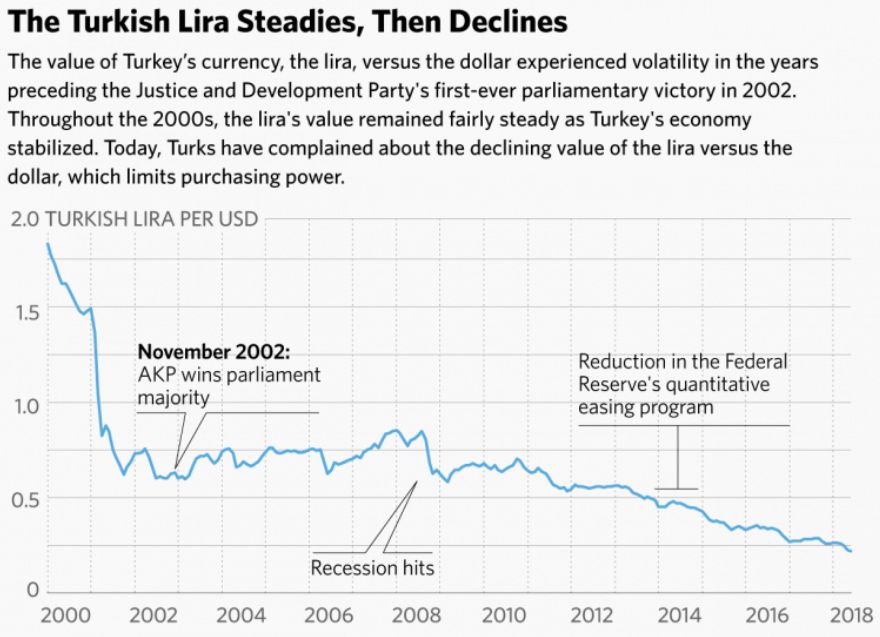
Argentina
Argentina, under
currency pressure from a rising dollar and a mountain of dollar-denominated
debt, faces a story similar to Turkey's. But in Argentina, the political damage
is likely already done: As the weak peso continues to feed stubbornly high
inflation, it will further erode President Mauricio Macri's support base.
What's more, under the conditions of a deal with the International Monetary
Fund for credit lines, Macri's government will probably have to cut public
spending, including transfers of funds to provincial governments. The cutback
will cause opposition governors to pressure the national government for more
money by pulling back congressional support for Macri's proposed legislation,
such as labor reform. Coupled with Argentina's growing trade and current
account deficits, voters' economic pain will push the next government toward
greater protectionism. It will likely resist moves from the Common Market of
the South, better known by its Spanish acronym, Mercosur, to explore additional
trade agreements, though deals that are already well underway - such as the
EU-Mercosur trade agreement - are safe. In time, Argentina will be out of step
with other Mercosur members, such as Uruguay and Paraguay, on foreign trade.
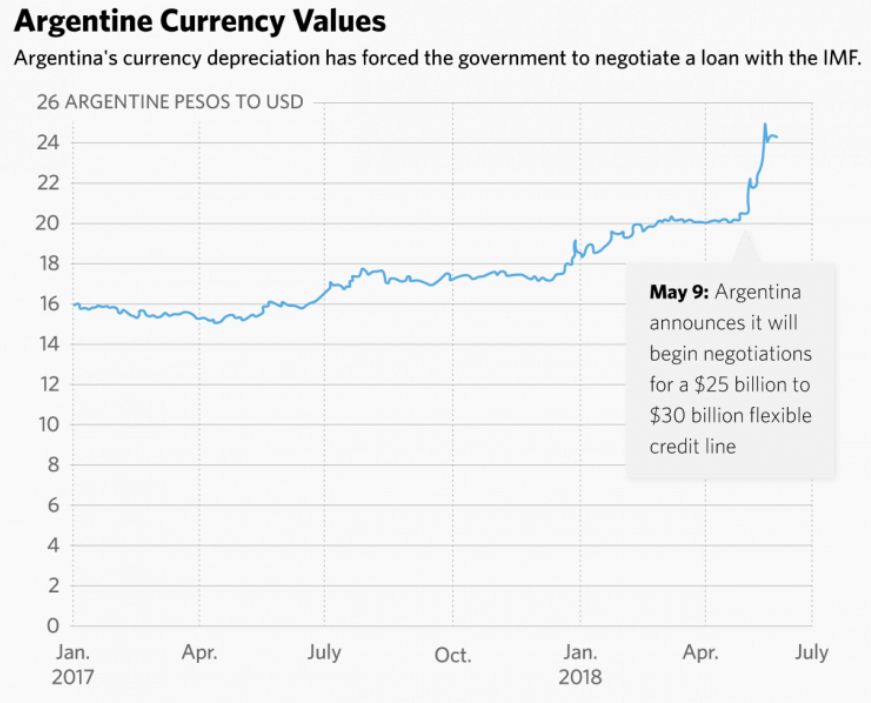
Mexico
In Mexico, the strong
U.S. dollar is already hitting the peso hard. Prolonged uncertainty over the North
American Free Trade Agreement renegotiation and a potential populist victory in
the presidential election this quarter threatens to create more economic
turmoil. Mexico will hold elections for the presidency and for Congress on July
1. Among the presidential contenders, populist candidate Andres Manuel Lopez
Obrador leads the pack. Lopez Obrador's political influence, should he become
president, will depend on whether he controls a congressional majority. Much of
his policy agenda, which includes a rollback of education reform, fuel price
freezes and cuts to the federal budget, will be virtually impossible to
implement without congressional consensus. Mexico's historically dominant
parties, the Institutional Revolutionary Party (PRI) and the National Action
Party (PAN), will form a tactical alliance in Congress to try to block Lopez
Obrador. In the event that Lopez Obrador picks up a majority in both houses,
PRI and PAN would have to rely on the courts to resist the president's more
controversial policies.
At this point, the
odds are looking slim that the United States will reach its goal of closing a
NAFTA deal ahead of the Mexican elections. Canada, Mexico and the United States
still have yet to agree on overall rules of origin requirement or on regional
content quotas for individual automotive components. While Canada could adapt
to the U.S. demand to shift a portion of vehicle production to higher-wage
areas, Mexico, which relies on lower wages for competitiveness, would find it
more difficult, if not impossible. And even if NAFTA's parties come to an
agreement in time, the White House is likely to face resistance from the U.S.
Congress if a deal lacks strong protections for investors and labor. Trump
could try to break the stalemate by threatening a withdrawal from the agreement
or by breaking the negotiation down to the bilateral level, but such extreme
moves on NAFTA would likely galvanize Congress to take legislative action to
prevent or nullify them.
Colombia
The Colombian peso
has fared far better than its regional peers, but there are still lingering
risks to the country's peace agreement with the Revolutionary Armed Forces of
Colombia (FARC) that will bear close watching this quarter. A pending
investigation into high-level FARC leaders by Colombian and U.S. authorities
will complicate things for the next government if a centrist or leftist
candidate comes to power in the June 17 runoff election. Depending on how far
the investigations go, the peace deal with the FARC could falter and put oil
companies and other businesses in northeastern and southwestern Colombia in
danger of extortion or attack. Colombia's next president will also be more
reluctant to sign new trade agreements as domestic industries come under
greater pressure. Pending trade agreements, particularly those with Turkey and
Japan, will be at risk unless their proposals for agricultural trade improve
significantly for Colombia.
Brazil
As presidential
campaigning picks up this quarter in Brazil for the October elections, the pace
of economic reforms will slow. Higher fuel prices are inspiring protests and
feeding a growing anti-establishment current in the country. In Congress,
lawmakers won't have the appetite to approve controversial measures like
pension reform. The traditional parties that back the current government, such
as the Brazilian Democratic Movement, will try to seal an alliance with as many
other parties as possible to try to fend off the anti-establishment threat
coming from right-wing lawmaker Jair Bolsonaro, environmentalist Marina Silva
and center-left nationalist Ciro Gomes.
India
For India, the
world's third-largest oil consumer, rising oil prices and a strengthening
dollar mean a wider trade deficit and investor outflows from the country's
equity and debt markets. These global developments are happening as the ruling Bharatiya Janata Party is ready to fund populist measures
to win votes ahead of the 2019 elections, suggesting that the fiscal
consolidation drive in the world's fastest-growing major economy will slow
through next year, while job creation stays sluggish.
India is walking a
tightrope among China, Russia and the United States. Prime Minister Narendra
Modi wants to avoid another politically costly standoff with China as he
campaigns for a second term in office. With that in mind, he's embarking on a
tactical recalibration with Beijing, suggesting the relationship between the
two nuclear giants will return to a state of managed tension, even as each side
quietly continues military and infrastructure buildups on the border. Facing
the threat of U.S. sanctions for its economic ties to Iran and its defense ties
to Russia, New Delhi will begrudgingly bargain for exemptions while balancing
with Russia. The U.S.-India relationship will be strained as a result. The
degree to which these irritants undermine the growing strategic defense
partnership between the two countries will become more evident when their
foreign and defense chiefs meet in July.
South Africa
As the 2019 elections
draw closer, South African President Cyril Ramaphosa is trying to have it both
ways: He needs to push a pro-business agenda to stimulate the economy while
pursuing populist measures to shore up the African National Congress's electoral
defenses. Ramaphosa will be focused mostly on winning over investors in the
next quarter before the 2019 campaign season gets into full swing, though
downward pressure on the rand threatens to ratchet populist pressures up.
Steadily rising investor confidence is likely to extend to the mining industry
as the new administration tries to streamline regulation and increase
transparency through a new mining charter. Anti-graft efforts, moreover, will
continue apace under Public Enterprises Minister Pravin Gordhan, who plans to
target South Africa's state-owned enterprises, a hotbed of corruption.
Venezuela
Venezuela is too far
gone for higher oil prices to alleviate its troubles this quarter. In fact, its
cratering oil production - already down by 500,000 barrels per day this year,
is a big factor behind the global shortfall. Production will fall further as
inflation worsens, currency shortages at state oil company Petroleos
de Venezuela become more acute and workers desert their posts. The Venezuelan
government, meanwhile, will try to keep local transport ships from docking at
oil terminals where creditors could seize the oil as payment for arbitration
awards and disrupt the country's energy export activities. Along with possible
U.S. sanctions on the energy sector, the threat of large-scale asset seizures -
which would raise the risk of unrest or even a coup - will loom large in
Venezuela this quarter.
For
updates click homepage here